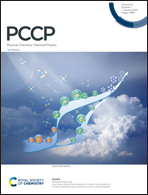Hydrogen evolution reaction of Ben + H2O (n = 5–9) based on density functional theory†
Abstract
The structural evolution of Ben clusters with n = 5–9, the adsorption energy created by the Ben@H2O (n = 5–9) complex, and the mechanism of the hydrogen evolution reaction of Ben + H2O (n = 5–9) were all studied using DFT calculations based on the PBE0-D3/Def2TZVP level. Excluding the Be7 cluster, the global minimum structures of beryllium clusters with n = 5–9 showed a higher point group pair formation. Be7 clusters’ high point group symmetry is unstable. Be9@H2O released the greatest energy during the complex's creation (−1.45 eV). Exothermic hydrogen evolution occurs in Ben + H2O (n = 5–9), and all transition states, intermediate stages, and products have energies lower than the equilibrium constant (EC). More energy is released when an O–H bond in the Ben@H2O (n = 5–9) complex is broken, and the energy release results in a change in the cluster structure, which is more pronounced in the Be7 + H2O reaction. Interestingly, there are eight transition states in the Be6 + H2O hydrogen evolution reaction, with the second O–H bond break requiring more energy than the first. There are only three transition states in the Be8 + H2O hydrogen evolution reaction, and the reaction energy is the greatest (−4.13 eV).



 Please wait while we load your content...
Please wait while we load your content...